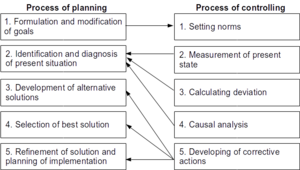Operational controlling
| Operational controlling |
|---|
| See also |
Operational business controlling is used to regulate the internal processes necessary to monitor and direct of the company in the short term. It allows making business decisions related to ongoing business operations. The main tasks of operational controlling include:
- controlling of the results,
- liquidity planning,
- monitoring of profitability,
- improving effectiveness of use of existing resources.
The process of operational controlling (also called business controlling) allows to convert strategic plans in the operational plans. These plans must be tailored to specific units that make up the whole company. The whole process takes often place in the so-called budgeting process.
Elements of operational controlling system
Basic elements of business controlling system are:
- internal reporting system,
- budgetary control,
- operational planning (budgeting).
Business controlling normally takes the form of budgetary control, and is performed by comparing the short-term performance of organizational units with those established in the budget. Then managers analyse the deviations of actual values from the values set in goals for specific unit and the whole company.
Role of operational planning and business controlling
It allows to identify intermediate objectives in relation to the objectives set in strategic planning. Operational planning includes:
- single event or action,
- small number of variables,
- execution of relatively simple tasks,
- balancing resources,
- aggregation of information,
- short time horizon.
Design of operational controlling system
The detailed design process consists of the following steps:
- Determination of the time, scope and field of controlling.
- Preparation - setting goals and plans.
- Selection of parameters, measures and indicators.
- Providing proper information sources across organization.
- Determining the procedure for monitoring deviations.
- Establishing rules for decision-making process.
- A decision on the implementation of the system.
- Determination of the detailed time schedule and financial resources needed for implementation
Operational controlling provides broad source of the information necessary to control main economic processes. This information pertains primarily of present business, performance and resource utilization.Operational controlling is closely linked and integrated with strategic controlling.
References
- Guide, V. D. R. (2000). Production planning and control for remanufacturing: industry practice and research needs. Journal of Operations Management, 18(4), 467-483.
- Maimon, O. Z. (1987). Real-time operational control of flexible manufacturing systems. Journal of Manufacturing Systems, 6(2), 125-136.
- Slack, N., Chambers, S., & Johnston, R. (2010). Operations management. Pearson education.
- Śliwczyński, B. (2011). Operational controlling-a tool of translating strategy into action. LogForum 7, 1, 5.
- Turner, J. R., & Keegan, A. (1999). The versatile project-based organization: governance and operational control. European Management Journal, 17(3), 296-309.
